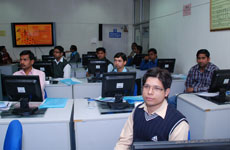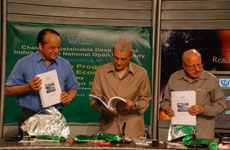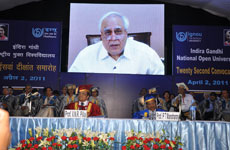The Growth Story (Social Commitment with Prudence)
Intro: The four-year period of the 11th Plan has witnessed impressive growth, consolidation and progress in the Education and Social Sector activities of IGNOU
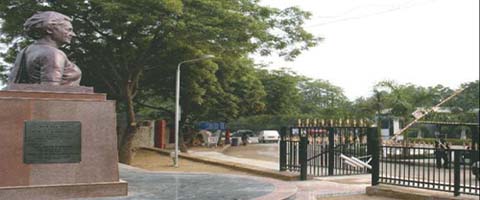
The four-year period beginning 2006-07 has been one of impressive growth and progress for the Indira Gandhi National Open University – The People’s University – catapulting it to the biggest among its peer institutions across the globe with over three million students.
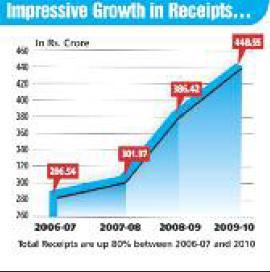
The University has also maintained its exacting standards as the premier national resource centre for open and distant learning and seamless provider of quality education, at par with other national and international institutions of higher learning.
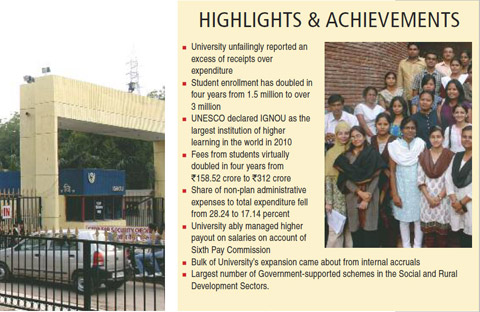
The University has also been unwavering in its commitment on access to education and equity in opportunities to women, members of Scheduled Castes and Scheduled Tribes, the rural population, remote areas, tribal regions, the differently-abled and the socially- and economically-weaker sections of society.
The bulk of IGNOU’s expansion has come about from internal accruals, notably the modest tuition fee that the University charges its students.

This has been possible because student enrollment has doubled in the past four years from about 1.5 million to over three million, prompting the United Nations Educational, Scientific and Cultural Organisation (UNESCO) to declare it the largest, most diverse and inclusive institution of higher learning in the world in 2010.
This is in marked contrast to the general trend for higher educational institutions in India, which continue to depend heavily on grant income even for operational expenditure, not to mention new growth initiatives.
The achievement is all the more noteworthy, considering that be it in 2006-07 or the three full financial years thereafter for which accounts have been audited, the University has unfailingly reported a surplus — or an excess of receipts over expenditure.
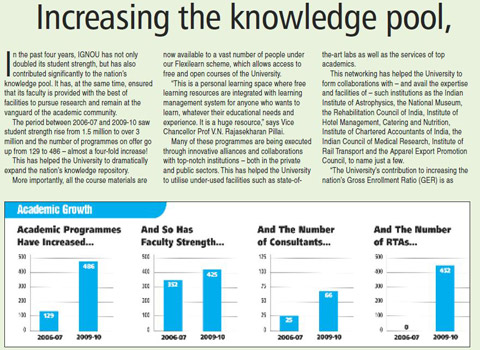
HOW DID THIS HAPPEN?
The primary reason why the University has reported excess of income over expenditure is that the fee generated from students has virtually doubled during the period under review – from Rs. 158.52 crore to Rs. 312 crore.
Accordingly, the bulk of the increase in total receipts – from Rs. 286.54 crore in 2006-07 to Rs. 448.55 crore in 2009-10 – has come from student fees, which now contribute a healthy 88 percent of internal revenue generation, against 82 percent in 2006-07. As a percentage of total receipts, student fee contributes 69.76 percent against 55.32 percent in the year 2006-07. “All this clearly shows that IGNOU has been able to generate sufficient money internally to fund its programmes and expansion, not just in India but also across the globe,” notes Prof V.N. Rajasekharan Pillai, Vice Chancellor.

He made a special mention of interventions such as the programmes being conceived and run for the armed forces, such as Gyan Deep for the Army and Akashdeep for the Air Force. A similar tie-up is soon to be formalised for personnel of the Indian Navy. These tie-ups alone have generated a revenue of almost `14 crore.
On the expenditure side, too, audited data reveals that money has been spent on some extremely productive purposes, such as financing the ‘Gyan Vani’ and ‘Gyan Darshan’ programmes, intended to widen the University’s outreach to every nook and corner of the country.
Against a mere `41 lakh spent on these two programmes in 2006-07, the expenditure was higher at Rs. 8.75 crore in 2009-10. The outreach, accordingly, also expanded.
‘Gyan Darshan’ is a 24-hour educational TV channel in collaboration with other institutions of higher learning, while ‘Gyan Vani’ is a large cooperative network of FM radio stations, exclusively devoted to education. Efforts are now on for two-way tele-conferencing, interactive radio counselling, and for relaying educational programmes through local FM radio stations.
This apart, expenditure also increased on account of expanding the regional outreach of the University – comprising a wide network of Regional Centres, Sub-Regional Centres and Study Centres across the country.
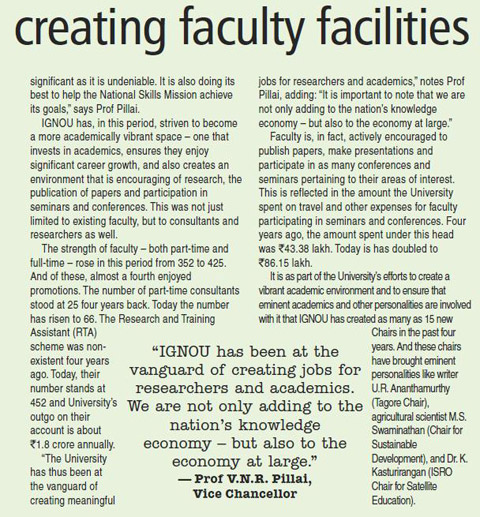
This is another stated mandate of the University. The expenses incurred on these centres more than doubled from Rs. 56.72 crore to Rs. 118.09 crore.
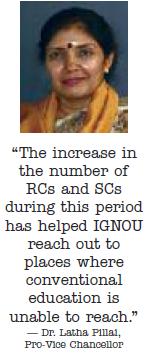
“The number of Regional Centres during this period has gone up from 59 to 62, while the number of Study Centres has risen from 1,468 to well over 3,000 – more than doubling. This has been of great help to students, and has helped the University to reach out to places where conventional education is unable to reach,” notes Pro-Vice Chancellor Dr Latha Pillai.
SOUND FINANCIALS,
HEALTHY REVENUES
If revenue expenditure alone is considered — which gives a fair idea of an institution’s financial health, especially those with social commitment – the operations of the University continued to generate a surplus – which stood at Rs. 69.25 crore during 2009-10.
The University, as did other autonomous institutions across the country, also bore a major additional burden on account of outgo toward salaries and wages.
The payment of arrears due to the generous award by the Sixth Pay Commission also added to the outgo. Payments toward salaries and wages – due to both higher payout and recruitment – went up from Rs. 35.68 crore to Rs. 86.12 crore.
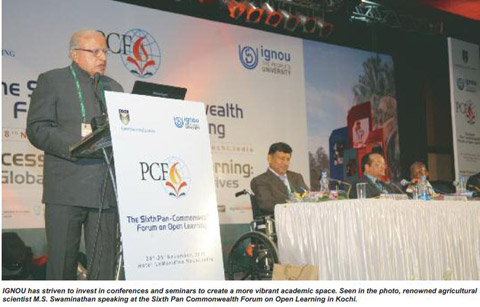
As a result, the percentage-expenditure under this head, which was hovering around 18 percent till a few years ago, ballooned to nearly 25 percent.
“IGNOU was one of the first Universities in the country to implement the recommendations of the Sixth Pay Commission, including clearing the arrears,” Prof Pillai points out.
Added to that, the non-plan expenditure toward staff welfare – due to the reasons aforesaid – also shot up from Rs. 9.23 crore to Rs. 57.02 crore. These expenses are toward contributions for the new pension scheme, bonus, pension, gratuity, leave encashment, leave salary, honorarium and other welfare schemes.
“This expenditure is also a necessary part of the University’s effort to keep its staff and faculty satisfied and maintain high productivity levels,” says Prof Pillai, adding that a concerted effort has been made to ensure that senior faculty members have independent rooms and personal assistants. All of them have also been issued laptops to increase efficiency and productivity.
With increased salaries, the University also had to incur a much higher expenditure toward terminal benefits, compared with earlier years. Total Quality Management remains the highest priority in all areas of operation of the University. Expenditure on staff welfare rose from Rs. 9.31 crore to Rs. 57.83 crore – an almost six-fold increase. As a percentage of expenditure this was a jump from 4.03 percent to 12.94 percent of expenditure.
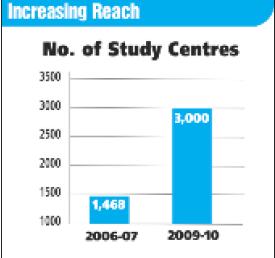
Against this backdrop, there has also been a concerted effort on the part of the University to curtail expenditure. This is the reason why the share of non-plan administrative expenses to total expenditure has fallen significantly from 28.24 percent in 2006-07 to 17.14 percent in 2009-10.
New strategies are also being evolved to mobilise resources so that the University can continue to work on its mandate without any financial impediment. In addition, maximising non-monetary inputs and achieving cost-effectiveness in operations and economy in spending also remain the guiding principle of the University.
Nonetheless, the Vice Chancellor has constituted a Committee under the chairmanship of Pro-Vice Chancellor Prof P.R. Ramanujam on how to curtail expenditure further. The suggestions and recommendations made by the Committee will be pursued in right earnest, Prof Pillai says.
Cover Story Box 1
In the past four years, IGNOU has not only doubled its student strength, but has also contributed significantly to the nation’s knowledge pool. It has, at the same time, ensured that its faculty is provided with the best of facilities to pursue research and remain at the vanguard of the academic community.
The period between 2006-07 and 2009-10 saw student strength rise from 1.5 million to over 3 million and the number of programmes on offer go up from 129 to 486 – almost a four-fold increase!
This has helped the University to dramatically expand the nation’s knowledge repository.
More importantly, all the course materials are now available to a vast number of people under our Flexilearn scheme, which allows access to free and open courses of the University.
“This is a personal learning space where free learning resources are integrated with learning management system for anyone who wants to learn, whatever their educational needs and experience. It is a huge resource,” says Vice Chancellor Prof V.N. Rajasekharan Pillai.
Many of these programmes are being executed through innovative alliances and collaborations with top-notch institutions – both in the private and public sectors. This has helped the University to utilise under-used facilities such as state-of-the-art labs as well as the services of top academics.
This networking has helped the University to form collaborations with – and avail the expertise and facilities of – such institutions as the Indian Institute of Astrophysics, the National Museum, the Rehabilitation Council of India, Institute of Hotel Management, Catering and Nutrition, Institute of Chartered Accountants of India, the Indian Council of Medical Research, Institute of Rail Transport and the Apparel Export Promotion Council, to name just a few.
“The University’s contribution to increasing the nation’s Gross Enrollment Ratio (GER) is as significant as it is undeniable. It is also doing its best to help the National Skills Mission achieve its goals,” says Prof Pillai.
IGNOU has, in this period, striven to become a more academically vibrant space – one that invests in academics, ensures they enjoy significant career growth, and also creates an environment that is encouraging of research, the publication of papers and participation in seminars and conferences. This was not just limited to existing faculty, but to consultants and researchers as well.
The strength of faculty – both part-time and full-time – rose in this period from 352 to 425. And of these, almost a fourth enjoyed promotions. The number of part-time consultants stood at 25 four years back. Today the number has risen to 66. The Research and Training Assistant (RTA) scheme was non-existent four years ago. Today, their number stands at 452 and University’s outgo on their account is about Rs. 1.8 crore annually.
“The University has thus been at the vanguard of creating meaningful jobs for researchers and academics,” notes Prof Pillai, adding: “It is important to note that we are not only adding to the nation’s knowledge economy – but also to the economy at large.”
Faculty is, in fact, actively encouraged to publish papers, make presentations and participate in as many conferences and seminars pertaining to their areas of interest. This is reflected in the amount the University spent on travel and other expenses for faculty participating in seminars and conferences. Four years ago, the amount spent under this head was `43.38 lakh. Today is has doubled to `86.15 lakh. It is as part of the University’s efforts to create a vibrant academic environment and to ensure that eminent academics and other personalities are involved with it that IGNOU has created as many as 15 new Chairs in the past four years. And these chairs have brought eminent personalities like writer U.R. Ananthamurthy (Tagore Chair), agricultural scientist M.S. Swaminathan (Chair for Sustainable Development), and Dr. K. Kasturirangan (ISRO Chair for Satellite Education).
Cover Story Box 2
A cursory look at the audited accounts may give an impression that the University’s corpus had “reduced” from Rs. 215.60 crore as on March 31, 2008 to Rs. 208.34 crore the next year and further to Rs. 187 crore a year later. But the fact is the University’s invested funds have actually increased.
This is how: During end-March 2010, long-term investments in Government bonds worth Rs. 56.80 crore attained maturity, out of which Rs. 40 crore pertained to the corpus fund, and the rest toward heads such as pension fund and security deposit.
Therefore, the invested amount against the corpus showed a lower figure of, `187 – that is reduced by Rs. 40 crore of matured government bonds.
The matured amount was re-invested in the following month – April. Accordingly, the corpus reflected the true picture in that month, showing an amount of Rs. 237 crore – that is `187 crore, plus the matured invested amount of `40 crore.
The same was true in 2009, when the corpus, it appeared, got reduced from Rs. 215.60 crore in the previous year to Rs. 208.34 crore. But that was not the case, as detailed above. Therefore, there was no question of any decline in the corpus.
Click here for previous Cover Stories

